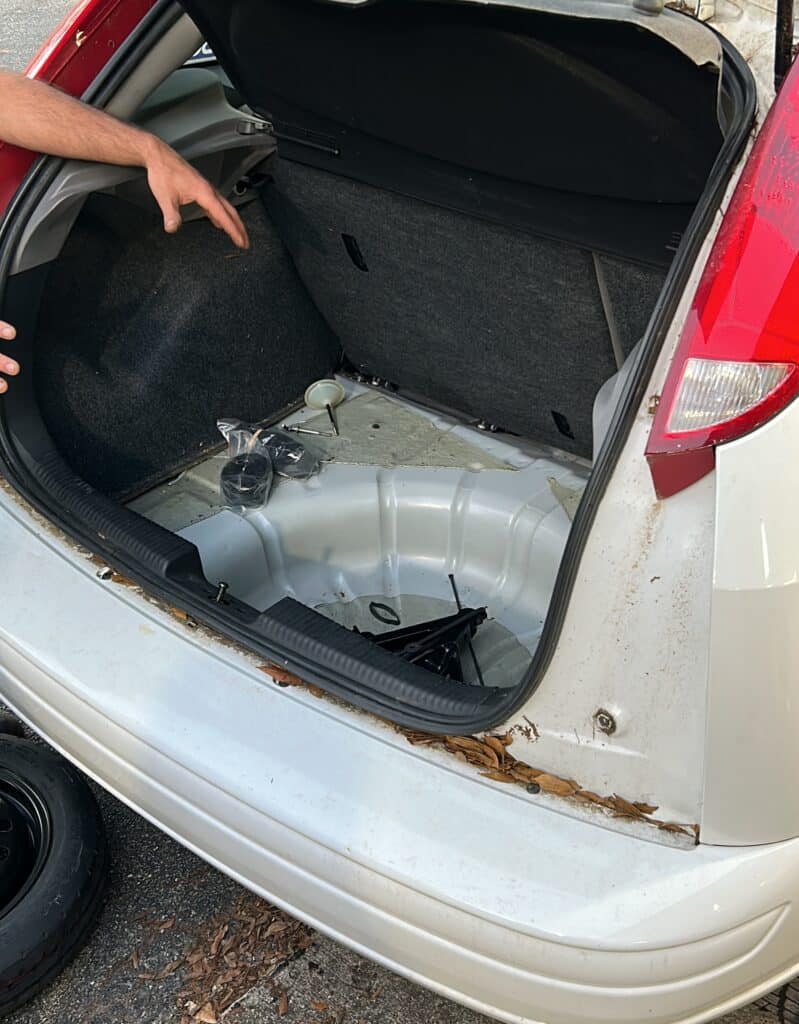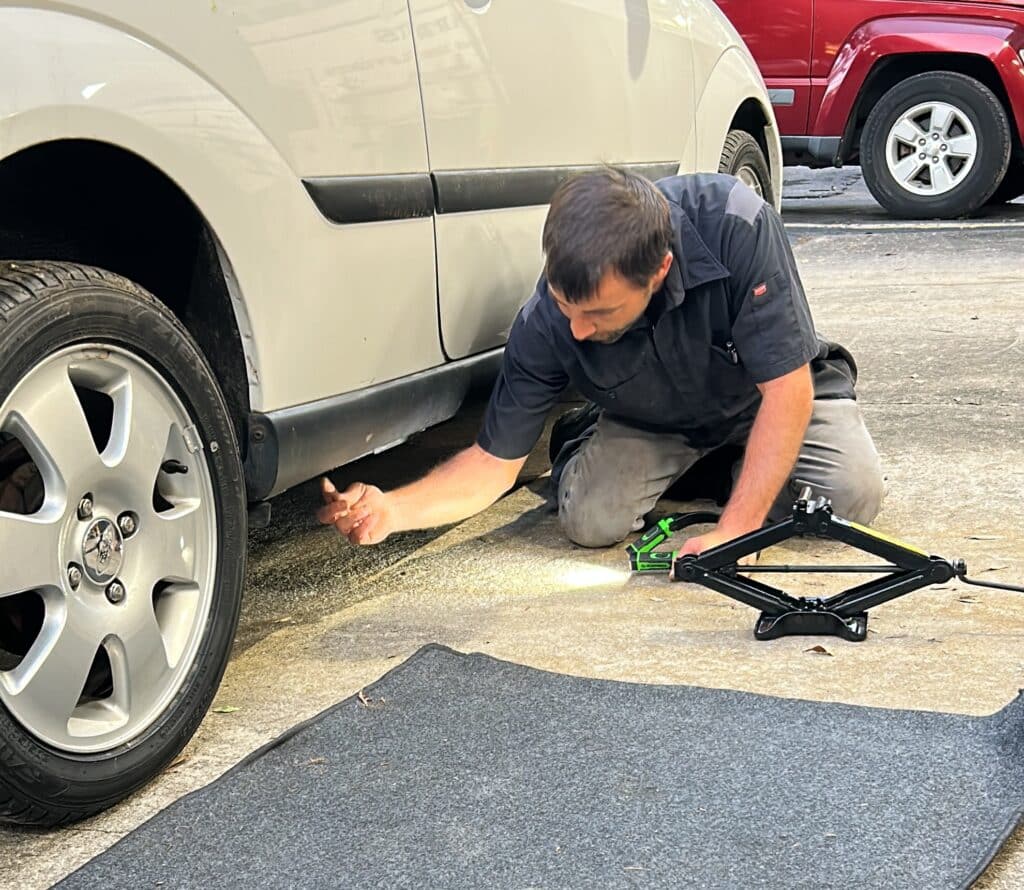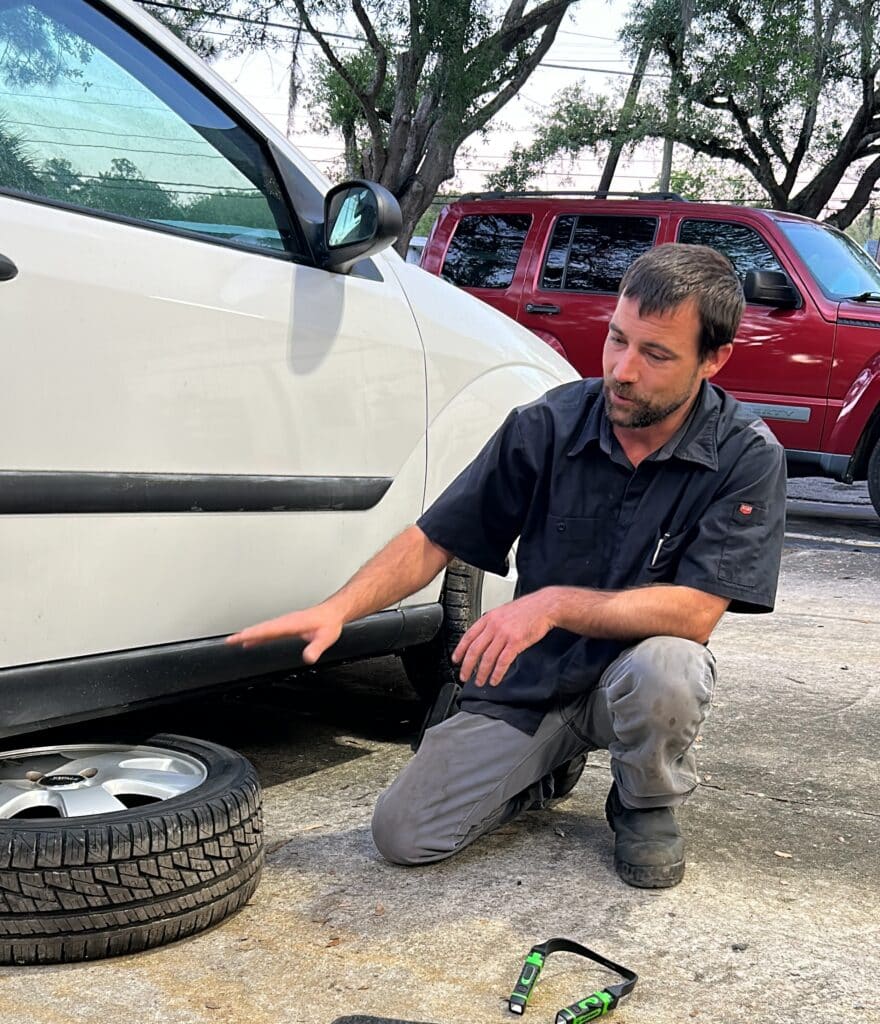How to Change a Tire
Getting a flat tire can be stressful in the moment. City Auto Repair has made this how-to guide to make changing a spare tire as smooth as possible. After you change your tire or you need assistance, call City Auto Repair at (352) 377-0383.
For easy access, keep our How To Change a Tire guide in your glovebox:
Download1. FIND A SAFE LOCATION
As soon as you realize you have a flat tire, do not abruptly brake or turn. Slowly reduce speed and scan your surroundings for a level, straight stretch of road with a wide shoulder. An empty parking lot would be an ideal place. Level ground is good because it will prevent your vehicle from rolling. Also, straight stretches of road are better than curves because oncoming traffic is more likely to see you.
Never attempt to change your tire on a narrow shoulder near oncoming traffic. Keep moving (slowly) until you find a safer spot. While driving on a flat risks ruining your rim, replacing a rim is better than being hit by an inattentive driver.
Make sure to consult your owner’s manual and review their specific steps on how to change a flat tire for your vehicle and where your spare tire is located. As you can see here, many spare tires are located under the carpet in your trunk.

Technician Tip: Use the carpet from your trunk as a mat to kneel on while you change your tire!
2. TURN ON YOUR HAZARD LIGHTS
Your hazard lights or “flashers” will help other drivers see you on the side of the road. To avoid an accident, turn them on as soon as you realize you need to pull over.
3. APPLY THE PARKING BRAKE
Once stopped, fully engage your parking brake. Always use the parking brake when preparing to replace a flat tire. This will minimize the possibility of your vehicle rolling.
4. APPLY WHEEL WEDGES
Wheel wedges go in front of or behind the tires to further ensure the vehicle doesn’t roll while you fix the flat tire. If you’re changing a rear tire, place these in front of the front tires. If your flat tire is at the front, put the wheel wedges behind the rear tires.
Bricks or large stones will work just as well as “real” wheel wedges. Just be sure they’re large enough to stop the car from rolling.
5. REMOVE THE HUBCAP OR WHEEL COVER
If your vehicle has a hubcap covering the lug nuts, it’s easier to remove the hubcap before lifting the vehicle with the jack. If your lug nuts are exposed, you can skip ahead to Step 6.
Use the flat end of your lug wrench to remove the hubcap. This will work for most vehicles, but some hubcaps need a different tool to come off. Consult your owner’s manual for proper hubcap or wheel cover removal procedures.
6. LOOSEN THE LUG NUTS
Using the lug wrench, turn the lug nuts counterclockwise until you break their resistance. You may have to use force, and that’s ok. Use your foot or all of your body weight if necessary.
Loosen the lug nuts about ¼ to ½ of a turn, but don’t remove them completely yet. Save that for when it’s time to remove your tire/wheel from the vehicle.
7. PLACE THE JACK UNDER THE VEHICLE
The right place for the jack is usually beneath the vehicle frame alongside the tire that’s flat. Many vehicle frames have molded plastic on the bottom with a cleared area of exposed metal specifically for the jack.
To safely lift and avoid damage to the vehicle, follow the instructions for jack placement in your vehicle owner’s manual.

8. RAISE THE VEHICLE WITH THE JACK
To prevent the jack from settling under the weight of your vehicle and coming off balance, place a small cut of 2×6” wood beneath it before attempting to raise your vehicle. This tactic is especially helpful on asphalt.
With the jack properly positioned, raise the vehicle until the flat tire is about six inches above the ground.
Never put any part of your body under the vehicle during or after raising the vehicle with the jack.

Technician Tip: Place the flat tire you removed underneath the frame in case your jack slips. This will prevent large injuries and your car frame from greater damage it could receive from falling on the asphalt.
9. UNSCREW THE LUG NUTS
Now it’s time to remove the lug nuts all the way. Since you’ve already loosened them, you should be able to unscrew them mostly by hand. Place the lug nuts in a secure place until you are ready to screw them back on.
10. REMOVE THE FLAT TIRE
Gripping the tire by the treads, pull it gently toward you until it’s completely free from the hub behind it. Set it on its side so that it doesn’t roll away.
11. MOUNT THE SPARE TIRE ON THE LUG BOLTS
Now place the spare on the hub by lining up the rim with the lug bolts. Push gently until the lug bolts show through the rim.
12. TIGHTEN THE LUG NUTS BY HAND
Put the lug nuts back on the lug bolts and tighten them all the way by hand clockwise. Once they are all on, check each one again, tightening as much as possible. You will tighten them with the wrench after lowering the vehicle to the ground.
13. LOWER THE VEHICLE AND TIGHTEN THE LUG NUTS AGAIN
Use the jack to lower the vehicle so that the spare tire is resting on the ground but the full weight of the vehicle isn’t fully on the tire. At this point, you should tighten the lug nuts with the wrench, turning clockwise, as much as you can. Push down on the lug wrench with the full weight of your body.
Look below to see the pattern you should tighten your lug nuts in:

14. LOWER THE VEHICLE COMPLETELY
Bring the vehicle all the way to the ground and remove the jack. Give the lug nuts another pull with the wrench to ensure they’re as tight as possible.
15. REPLACE THE HUBCAP
If the hubcap you took from the flat tire will fit your spare, put it in place the same way you removed it initially. If it doesn’t fit, stow it away with the tire when you stow your equipment.
16. STOW ALL EQUIPMENT
You have before you a jack, a lug wrench, wheel wedges, your flat tire, and possibly a hubcap. Don’t forget to put all of them in your vehicle before driving away.
17. CHECK THE PRESSURE IN THE SPARE TIRE
You should check the tire pressure of the spare tire to make sure that it is safe to drive on. “T-Type” temporary spares, also called “mini-spares,” require 60 psi (420 kPa). If the tire needs pressure, drive (slowly) to a service station immediately.
18. TAKE YOUR FLAT TIRE TO A TECHNICIAN
Temporary spare tires aren’t made to drive long distances or at high speeds, so drive cautiously until you’re able to visit a tire repair facility. A professional should be able to determine whether your tire needs a repair or if it’s time to replace it.
HOW LONG DOES IT TAKE TO FIX A FLAT TIRE?
Aside from taking your tire to a professional, the above procedure shouldn’t take more than 15 to 30 minutes to change a tire. Just be sure you don’t leave out any steps.
It’s a good idea to practice changing a tire in your garage or driveway to ensure you’re ready to handle this situation if it ever happens to you!
Call City Auto Repair
After you change your spare, come to City Auto Repair or call us at (352) 377-0383 to repair or replace your flat tire. We will make sure all your tires are fully functioning and safe to continue driving on!
